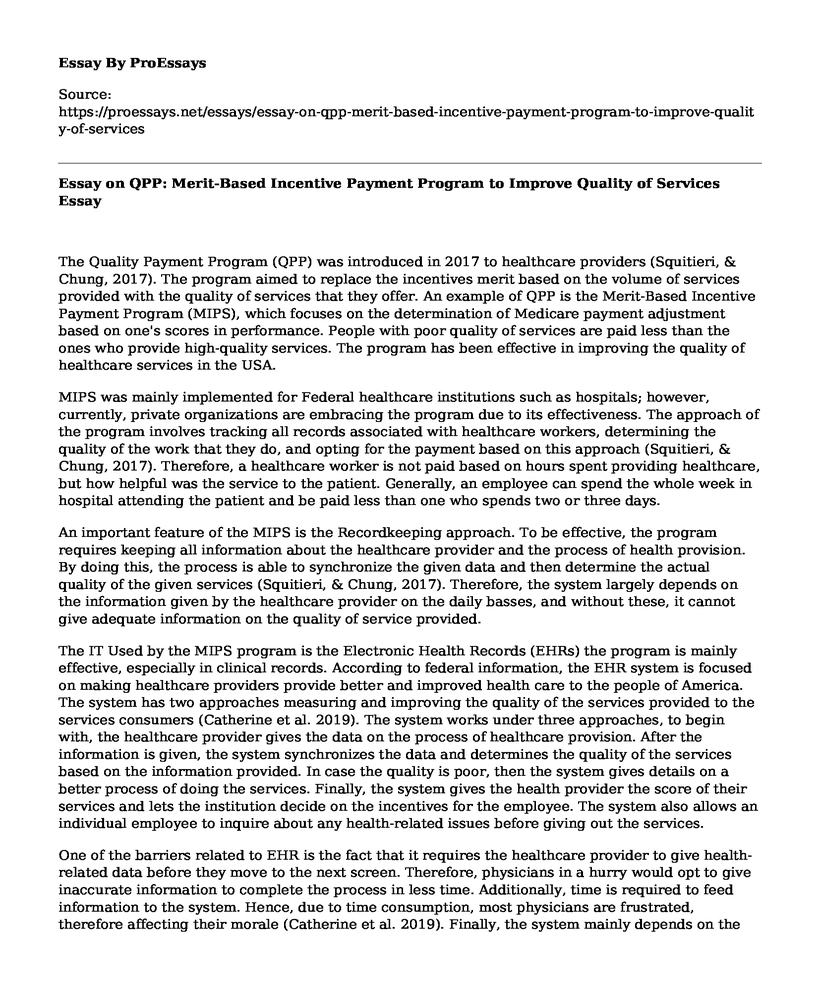The Quality Payment Program (QPP) was introduced in 2017 to healthcare providers (Squitieri, & Chung, 2017). The program aimed to replace the incentives merit based on the volume of services provided with the quality of services that they offer. An example of QPP is the Merit-Based Incentive Payment Program (MIPS), which focuses on the determination of Medicare payment adjustment based on one's scores in performance. People with poor quality of services are paid less than the ones who provide high-quality services. The program has been effective in improving the quality of healthcare services in the USA.
MIPS was mainly implemented for Federal healthcare institutions such as hospitals; however, currently, private organizations are embracing the program due to its effectiveness. The approach of the program involves tracking all records associated with healthcare workers, determining the quality of the work that they do, and opting for the payment based on this approach (Squitieri, & Chung, 2017). Therefore, a healthcare worker is not paid based on hours spent providing healthcare, but how helpful was the service to the patient. Generally, an employee can spend the whole week in hospital attending the patient and be paid less than one who spends two or three days.
An important feature of the MIPS is the Recordkeeping approach. To be effective, the program requires keeping all information about the healthcare provider and the process of health provision. By doing this, the process is able to synchronize the given data and then determine the actual quality of the given services (Squitieri, & Chung, 2017). Therefore, the system largely depends on the information given by the healthcare provider on the daily basses, and without these, it cannot give adequate information on the quality of service provided.
The IT Used by the MIPS program is the Electronic Health Records (EHRs) the program is mainly effective, especially in clinical records. According to federal information, the EHR system is focused on making healthcare providers provide better and improved health care to the people of America. The system has two approaches measuring and improving the quality of the services provided to the services consumers (Catherine et al. 2019). The system works under three approaches, to begin with, the healthcare provider gives the data on the process of healthcare provision. After the information is given, the system synchronizes the data and determines the quality of the services based on the information provided. In case the quality is poor, then the system gives details on a better process of doing the services. Finally, the system gives the health provider the score of their services and lets the institution decide on the incentives for the employee. The system also allows an individual employee to inquire about any health-related issues before giving out the services.
One of the barriers related to EHR is the fact that it requires the healthcare provider to give health-related data before they move to the next screen. Therefore, physicians in a hurry would opt to give inaccurate information to complete the process in less time. Additionally, time is required to feed information to the system. Hence, due to time consumption, most physicians are frustrated, therefore affecting their morale (Catherine et al. 2019). Finally, the system mainly depends on the information given by the healthcare providers and cannot detect the quality of services that they give, in case they lie hence could not be genuinely effective. Generally, healthcare providers could offer poor quality health services and give the system a high-quality service process. By doing this, employees are paid more incentive than the services they give to the patients.
References
Catherine, L. H., Elizabeth, T., Olivia, K. B., Michael, G. T., & Suzanne, L. W. (2019). Moving from quality measurement to quality improvement: Applying meaningful use lessons to the quality payment program. Perspectives in Health Information Management, 16(Fall). Retrieved from https://www.ncbi.nlm.nih.gov/pmc/articles/PMC6931051/
Squitieri, L., & Chung, K. C. (2017). Measuring provider performance for physicians participating in the merit-based incentive payment system (MIPS). Plastic and reconstructive surgery, 140(1), 217e.
Cite this page
Essay on QPP: Merit-Based Incentive Payment Program to Improve Quality of Services. (2023, Apr 24). Retrieved from https://proessays.net/essays/essay-on-qpp-merit-based-incentive-payment-program-to-improve-quality-of-services
If you are the original author of this essay and no longer wish to have it published on the ProEssays website, please click below to request its removal:
- Experience of Adult Patients with Tracheotomy in Situ
- Rising Cost of Pharmaceuticals Research Example
- Paper Example on Venturing into Retail Investment
- Risk Reduction Strategies Aimed at Preventing Wrong Site Surgery
- Essay Sample on King's College Hospital
- Research Paper on HIV Issue in India
- Fire Incidence on Carnival's Cruise Ship "Splendor" Essay Example







